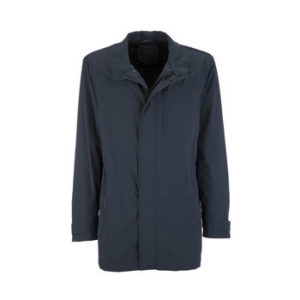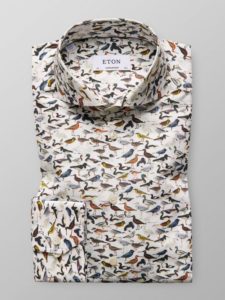Cleaning Smooth Leather Shoes from Robert Smart Menswear in York
Remove dirt by cleaning with a leather cleaner made specifically for smooth leathers. You can use saddle soap or a smooth leather shoe cleaner.
Shoe cleaners come in gels, foams, sprays, liquids and creams. Many leather cleaners come with an applicator top, or you can use a soft shoe brush to aid in removing dirt from the surface of the shoe. This will also help to remove dirt from any cracks in the shoes.
After cleaning, let the shoes dry for a few minutes and begin shining the shoes with a soft cotton cloth – either a shoe shine cloth, or even an old t-shirt, as long as it’s soft and made of cotton.
Conditioning Leather Shoes
Conditioning your leather shoes will help soften and moisturize the leather, and protect it from drying out and cracking. Certain types of leather, and shoes worn in dryer climates might need to be conditioned more often.
Some shoe cleaning products will clean and condition your shoes, but if you want your shoes to get the full treatment, or used a product specifically for cleaning, the next step is to condition your smooth leather shoes.
Of course, you’ll want a conditioner made for the specific type of shoe you’re working on. Also, look for a natural conditioner that is absorbed into the material of the shoe, as opposed to a synthetic conditioner that sits on top of the surface.
Rub small amounts of conditioner into the shoe, until the entire shoe has been covered with conditioner. After a couple of minutes, wipe any remaining conditioner off of the shoes, as the leather will only absorb what it can.
Most of the products you’ll use for leather shoe care can be found at general stores, shoe stores and shoe repair shops. If you are nervous about working on your own shoes, of course, any shoe repair shop will be happy to clean, polish and condition your shoes for a price.
To do a full and thorough session of leather shoe care, you’ll want the following items. Be sure the products you buy are recommended for smooth leather shoes.
• Newspapers
• Gloves
• Soft Cotton Cloths or Rags
• Soft Shoe Brush (optional)
• Smooth Leather Shoe Cleaner
• Leather Conditioner for Smooth Leather Shoes
• Shoe Polish, or a Shoe Polish Alternative
• Leather Protectant (Waterproofing Product)
The following pages will discuss these items in more detail, but it is most important that you follow the instructions that come with the products you buy, and be certain to only use products designed specifically for the materials of your shoes. i.e. Do not use these instructions or a product made for smooth leather to clean suede shoes!
Before you begin, you’ll want to make sure to you’re prepared for the shoe care process. Work on top of newspaper, wear gloves, and work in a well-ventilated area. These precautions are essential, as many shoe care products contain toxic chemicals that can be very harmful – more information on this in the shoe polish section of this article.
Cleaning Smooth Leather Shoes
Remove dirt by cleaning with a leather cleaner made specifically for smooth leathers. You can use saddle soap or a smooth leather shoe cleaner.
Shoe cleaners come in gels, foams, sprays, liquids and creams. Many leather cleaners come with an applicator top, or you can use a soft shoe brush to aid in removing dirt from the surface of the shoe. This will also help to remove dirt from any cracks in the shoes.
After cleaning, let the shoes dry for a few minutes and begin shining the shoes with a soft cotton cloth – either a shoe shine cloth, or even an old t-shirt, as long as it’s soft and made of cotton.
Conditioning Leather Shoes
Conditioning your leather shoes will help soften and moisturize the leather, and protect it from drying out and cracking. Certain types of leather, and shoes worn in dryer climates might need to be conditioned more often.
Some shoe cleaning products will clean and condition your shoes, but if you want your shoes to get the full treatment, or used a product specifically for cleaning, the next step is to condition your smooth leather shoes.
Of course, you’ll want a conditioner made for the specific type of shoe you’re working on. Also, look for a natural conditioner that is absorbed into the material of the shoe, as opposed to a synthetic conditioner that sits on top of the surface.
Rub small amounts of conditioner into the shoe, until the entire shoe has been covered with conditioner. After a couple of minutes, wipe any remaining conditioner off of the shoes, as the leather will only absorb what it can.
As I was looking for certain shoe polish products, I was surprised to find warnings that shoe polish contained toxic chemicals and could actually be considered very dangerous.
While I know most of us have had shoe polish around the house for years, probably without any problems, the warnings I found were of enough concern to me that I wanted to share the information with all of you. Below is more information about the toxicity of certain shoe polishes, as well as alternative and traditional polishing instructions.
Toxicity of Shoe Polish
Certain shoe polishes contain toxic chemicals that can be absorbed through the skin and or inhaled (read more at the epa web site).
It is essential that if you use shoe polish, you wear gloves when doing so, do not drink alcohol while polishing shoes (it can increase the effects of certain chemicals), and keep all shoe polish out of reach of children and animal companions.
If used, shoe polish should be used in a well-ventilated area, and all of the product shoud be used, with any residual being discarded or given to someone who will use it.
When disposed, shoe polish needs to be handled as a hazardous househould substance. Rags or clothes used that come in contact with the shoe polish should also be immediately discarded.
While some shoe polished claim to be non-toxic, most do not list their ingredients, so it is impossible to know that they are truly free of dangerous chemicals. While it is better to avoid shoe polish if possible, if this is not practical for you, and you do feel the need to buy commercial shoe polish – please use the necessary precautions.
Alternatives to Using Traditional Shoe Polish
Take your shoes to a shoe repair shop to have them cleaned and polished for you.
Rub your smooth leather shoes (not suede or nubuck) with the inside of a banana peel (test this method first on a small spot of the shoe), then buff and shine with a soft cloth or rag.
Olive oil or walnut oil works for smooth leather as well. Work a small amount into shoe, and polish with a soft cotton cloth. Again, try this method in an inconspicous spot before using the oil on the entire shoe.
Polishing Your Leather Sh oes with Traditional Shoe Polish
Shoe polishes are available in liquid, cream or paste. Liquid shoe polish dries quickly, but is not readily available in a lot of colors and does not last as long as the other options. Shoe polish paste is the longest lasting, but is very messy and slow to work with. Shoe polish cream is a great compromise, and is available in lots of colors.
Of course you’ll need to get the appropriate color of polish for you shoes. You can find a variety of shoe polishes at shoe stores, shoe repair shops and supermarkets, although you won’t find a large variety of colors at the latter. There are also several places on the web where you can find shoe polish. Apply the polish to a small, less conspicous area of the shoe to test and be sure the color is right.
Rub the polish into the shoe with a soft cloth, and allow it to dry thoroughly.
After the shoe polish is dry, shine your shoes by buffing them with a soft cloth or brush made specifically for shining shoes.
Weatherproofing your leather shoes will help to protect them from water and other elements that can ruin the finish and shorten the life of your shoes.
The Right Protectant for Your Shoes
Different weatherproofing products serve different purposes, so you should choose wisely. For example, if it is essential that your shoes are waterproof because you spend a lot of time in wet or messy conditions, and a pretty finish is not as is important, a beeswax product would be a better choice than a protective spray.
Beeswax products form a protective layer over the surface of the shoe or boot instead of being absorbed into the leather. This provides a better barrier against water, but the additional layers can alter the appearance of the shoes.
If the appearance of the shoe or boot is of more importance than the weatherproofing properties, a spray protectant should do the trick. By providing a breathable barrier against mild to moderate wet conditions and dirt, this type of weatherproofing product is virtually invisible on your shoes or boots.
There are a large variety of waterproofing products including those for smooth leather, suede or nubuck.
Additional Tips for Leather Shoe Care
If your leather shoes have a lot of old polish buildup, you may want to use a pre-cleaner.
- Don’t try to use shoe polish to change the color of your shoes. If you need your shoe color changed, consult a shoe repair shop.
- Remove any laces before beginning. Laces can be cleaned separately or replaced if they are in really bad shape.
- The next time you buy a pair of leather shoes, condition them before ever wearing them. This will help insure that your shoes are best protected from the start, and will save time on future cleanings.






